The diseases, damage and infestations suffered by hundreds of thousands of caged salmon in Scotland have been exposed by more than 300 graphic photos released by the Scottish Government.
Pictures taken since 2015 by fish health inspectors investigating mass deaths at salmon farms along the west coast and on islands reveal eight diseases, bloody lesions, eye damage, deformed organs, plagues of flesh-eating sea lice and much else.
The images – released under freedom of information law and published exclusively by The Ferret – have appalled animal welfare campaigners. They said the abuse was “shocking and stomach-churning”, and have called for a consumer boycott while threatening legal action.
But the Scottish Government stressed the importance of putting the photos into context, insisting they were not representative of the entire farmed fish population. The fish farming industry said that most of its salmon were healthy and it strived “to constantly maximise our fish health.”
Salmon farming, which earns £600 million a year as Scotland’s biggest food export, has been hit by a raft of problems with disease and lice in recent years. After decades of expansion, production dropped by around five per cent in both 2015 and 2016, and is forecast to fall by 11 per cent in 2018.
The industry has been strongly criticised by one committee of MSPs at Holyrood, and is under investigation by another. But it remains committed – backed by the Scottish Government – to double its business from £1.8 billion in 2016 to £3.6 billion by 2030.
The photos from 30 investigations by the Scottish Government’s Fish Health Inspectorate in Aberdeen over the last four years, were released to an anti-fish-farming campaigner on 15th June. Officials previously refused to hand them over twice since March, quoting exemptions to freedom of information legislation.
The investigations were into outbreaks of disease and other issues at 27 fish farms run by six companies. The majority – 15 – were at farms operated by Marine Harvest, along with four run by The Scottish Salmon Company, three by Scottish Sea Farms, three by Cooke Aquaculture, two by Greig Seafood, two by Loch Duart and one not known.
The farms were along the west coast at Loch Linnhe, Loch Torridon, Loch Kishorn, Loch Fyne and elsewhere, as well as on Mull, Skye, Lewis, Harris and Shetland. Amongst the eight diseases found were amoebic gill disease, poxvirus, pancreas disease, bacterial kidney disease, cardiomyopathy syndrome and pasteurella skyensis.
More than 120 salmon were sampled from farms where hundreds of thousands fish had died, at rates of up to 19 per cent of total stock a week. Post-mortems carried out and published by inspectors reported “moribund and lethargic fish with large lesions”, “large numbers of lethargic fish with physical damage” and “physical damage attributed to handling”.
The inspectors highlighted widespread problems with sea lice infestations, saying that sampled fish had “severe lice damage to their heads” and a “high lice burden”. They also found “no eyes”, “gross haemorrhaging”, “deformed hearts”, “enlarged spleens”, “anorexia”, “necrotic” gills and “yellow pseudo faeces”.
Don Staniford, a veteran campaigner from Scottish Salmon Watch, obtained the photos. “The ugly truth is that Scottish salmon is diseased, deformed and comes from farms where welfare abuse is shocking and stomach-churning,” he said.
“People buying Scottish salmon should seriously question supporting such a cruel form of food production. Shame on Scottish salmon farmers and shame on supermarkets for supporting such an ethically bankrupt form of farming.”
Staniford promised to file a legal challenge against Scottish salmon farms for breaches of the Animal Health and Welfare (Scotland) Act 2006, citing violations of provisions on “unnecessary suffering” and “cruel operations”. He pointed out that a salmon farmer in Norway had recently been fined £460,000 (five million NOK) for breaches of Norwegian animal welfare law.
“Cheap farmed salmon comes at a huge cost to fish welfare as well as environmental costs,” he added. “Consumers really must take into account the shocking abuses on salmon farms when making purchasing decisions. Anyone with a morsel of morals seeing such gruesome images would surely boycott Scottish salmon.”
The Scottish animal welfare charity, OneKind, described the photos as a “grim catalogue of horrors”. It was more evidence that suffering and disease had become “endemic” on salmon farms, said director Harry Huyton.
“Whoever is responsible for allowing these poor fish to suffer in this way should be held accountable, and relevant animal welfare legislation should be applied just as it would be for any other farmed animal,” he told The Ferret.
“We’re calling for an urgent and comprehensive review of welfare on fish farms, and in the meantime the Scottish Government’s ambition to grow the industry must be put on hold.”
Dr Krzysztof Wojtas, head of fish policy at Compassion in World Farming, urged salmon farmers to take animal welfare more seriously. “The high level of disease and mortalities we see in the salmon farming sector make it clear that this industry is operating beyond its limits, with very little respect for animal welfare,” he said.
“Salmon are kept in very high densities where sea lice can thrive and cause major welfare problems. They are subject to painful, stressful treatments to rid them of these lice, and high fish death rates become an accepted result.”
John Robins from Animal Concern called on the Scottish Government to control the fish farming industry instead of promoting it. “Filthy floating factory fish farms cause terrible suffering to the salmon imprisoned in them and they expose wild salmon and sea trout to a huge risk from numerous diseases and parasites,” he said.
When releasing the photos, the Scottish Government stressed that they must be seen in context. They were taken as as part of statutory inspection programme by the Fish Health Inspectorate (FHI).
“FHI’s mission is to support the Scottish Government’s vision of a sustainable, growing and diverse aquaculture industry whilst maintaining the high health status of farmed and wild fish and shellfish stocks in Scotland by preventing the introduction and spread of listed and emerging disease,” said the director of Marine Scotland, Graham Black.
“The FHI do this by undertaking statutory inspection and sampling programmes, providing advice to stakeholders and implementing regulatory functions in accordance with the current aquaculture and aquatic animal health regulations.”
The photos were part of a “risk based surveillance programme” which involved 160 fish farm inspections in 2017. “Photographs are taken as they are a useful tool in the analytical process,” he added.
“Fish are subject to a number of pressures in the environment, particularly naturally present pathogens and other environmental parameters, with farmed fish being no exception. It can therefore be expected that some fish will experience challenges to good health.”
Black pointed out that in many cases FHI inspections had been undertaken in support of company investigations. “Those fish which have been removed by the FHI represent a very small proportion of the total number of fish on an aquaculture site – for example five fish from sites holding between 250,000 to 1.8 million fish,” he said.
“The images do not present any human health concerns and are not a representation of the entire fish population on site.”
The Scottish Government also pointed out that circumstances differed for each inspection. “In May we published a framework for farmed fish health, co-produced with the aquaculture industry, to ensure a strategic approach to fish health and welfare in Scotland,” added a government spokesperson.
The Scottish Salmon Producers’ Organisation, which represents fish farming companies, argued that maintaining good health and welfare was at the heart of a successful industry. “We strive to constantly maximise our fish health,” said the organisation’s chief executive, Julie Hesketh-Laird.
“Occasionally fish health issues do arise, though the overwhelming majority of salmon grown in Scotland are healthy, and that is down to the skill and good farming practice of those who rear salmon.”
She added: “The photos released are not representative of an industry which produces millions of high quality salmon each year and invests heavily in research and development into new measures to protect fish health and welfare.”
Marine Harvest also emphasised the importance of animal welfare and survival for farmers. “However, over a three-year lifespan, some salmon will die for a variety of reasons, including challenges created by global warming and the resulting increase in sea water temperatures,” said the company’s head of fish health, Dr Meritxell Diez Padrisa.
“We work closely with animal welfare groups and all our farms are audited as part of the RSPCA assured scheme, which also provides additional checks and balances to ensure we are raising our fish in a safe and responsible way.”
The Scottish Salmon Company said it adopted a “best practice approach” to animal husbandry. “Like any farming there can be occasional health issues,” stated a company spokesperson. “These are diagnostic images and are not representative of our operations.”
According to Scottish Sea Farms, its inspections were due to an “isolated incident” in 2017. “No-one regrets any incidence of disease or ill-health more than our own farmers,” said the company’s head of fish health, Ralph Bickerdike.
“Given the low number of wild salmon to survive the marine environment, some level of mortality amongst farmed salmon, whilst regrettable, is to be expected. We’re happy to report that Scottish Sea Farms has had a really positive first half of 2018, with high survivability and low sea lice levels across all our farms.”
Grieg Seafood in Shetland and Skye stressed it was a responsible farmer. “We are committed to ensuring the highest standards of fish health and welfare are met across all our farms, which extends to a population of hundreds of thousands,” said managing director, Grant Cumming.
“Our focus is to first prevent disease from occurring and then, if it does occur, to ensure the welfare of the fish through responsible and effective treatment. While we do our utmost to avoid and minimise fish mortality, if it does occur we act quickly to ensure they are disposed of safely and in a legal and environmentally responsible manner.”
Loch Duart was proud of its reputation for producing high quality farmed salmon with the “very best” fish welfare. “This is achieved by giving them only high quality feed with a high marine content, along with low stocking rates which produces healthier fish,” said the company’s managing director, Alban Denton.
“Currently our salmon are virtually free from sea lice, as evidenced by the published data, and we have had no need for sea lice medicinal treatment on any of our farms for over 11 months.”
Cooke Aquaculture has not responded to a request to comment.
Photos thanks to Marine Scotland and Don Staniford. They can be cross-referenced by date and case number with the detailed inspection reports published by Marine Scotland’s Fish Health Inspectorate.












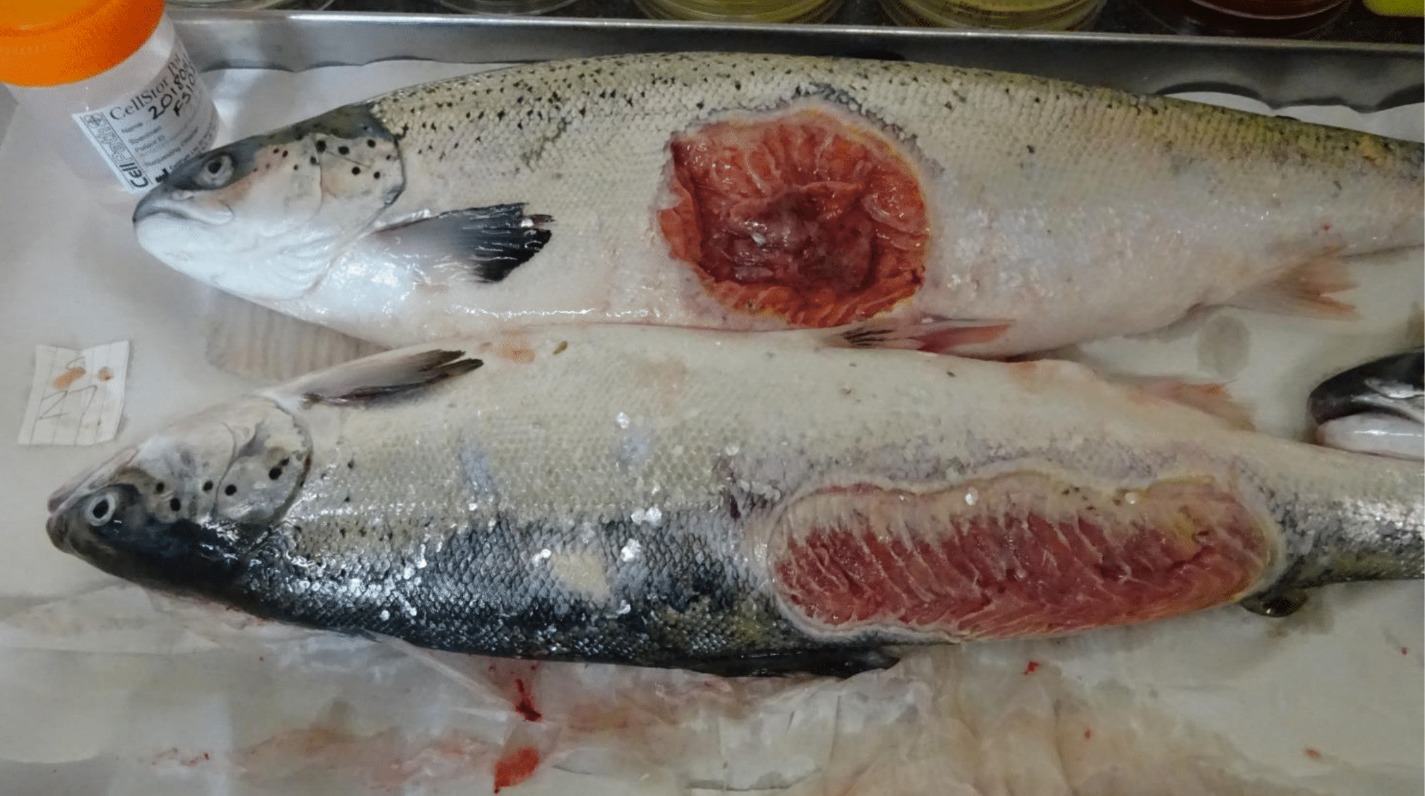
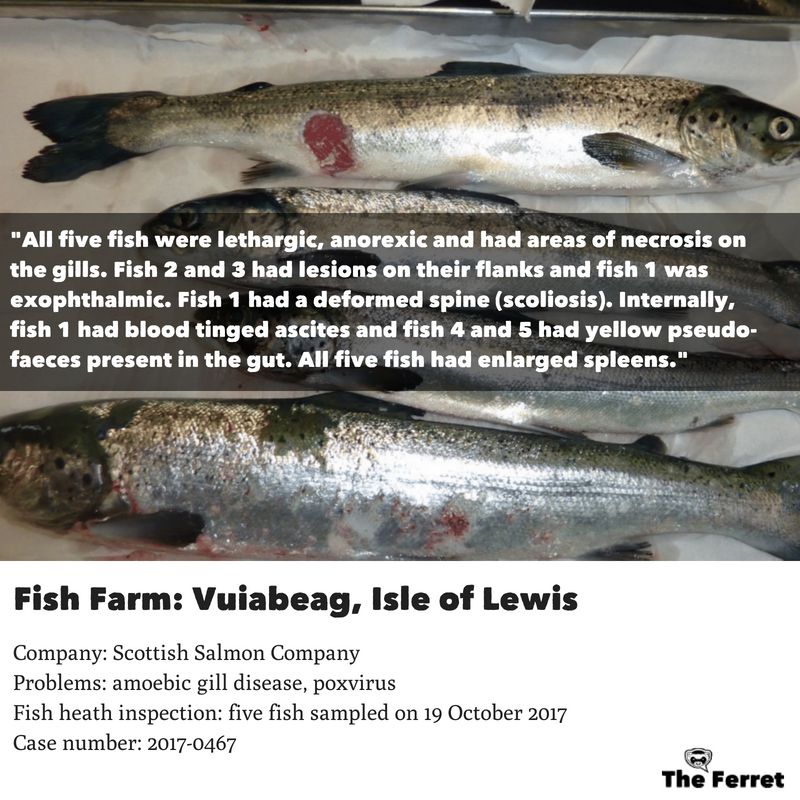
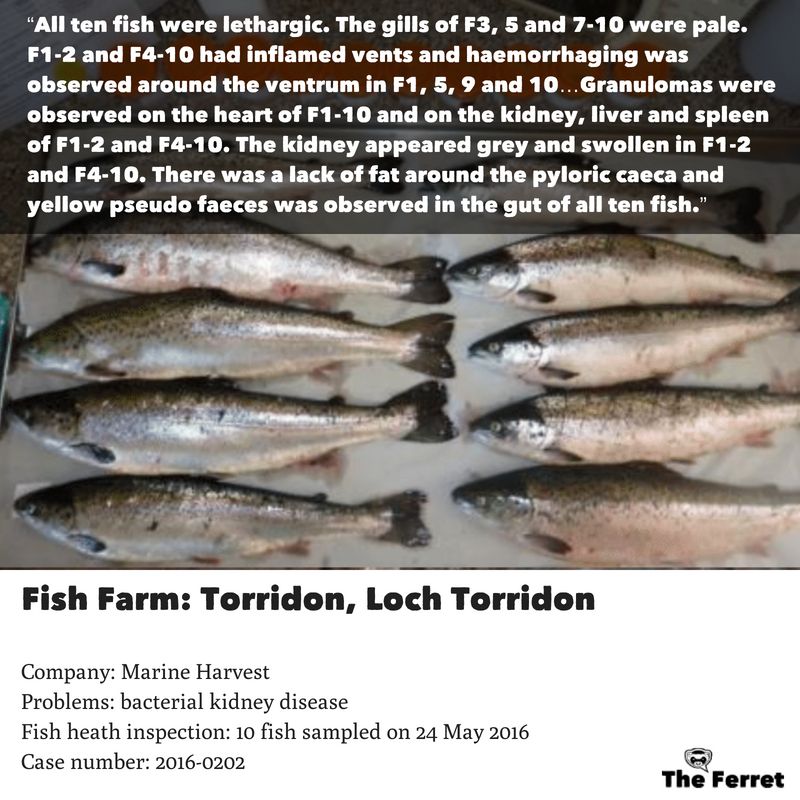

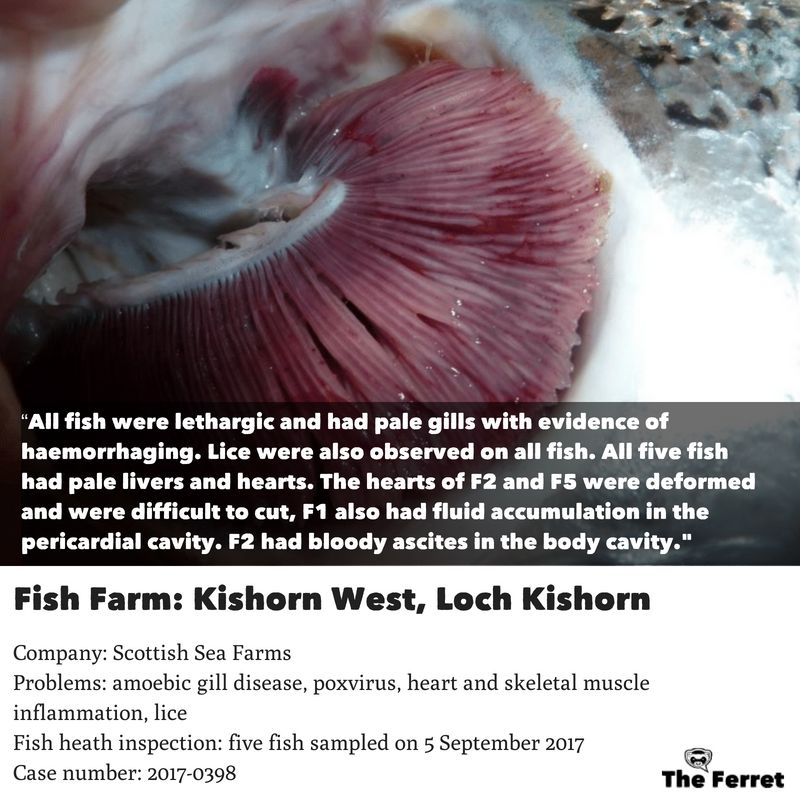
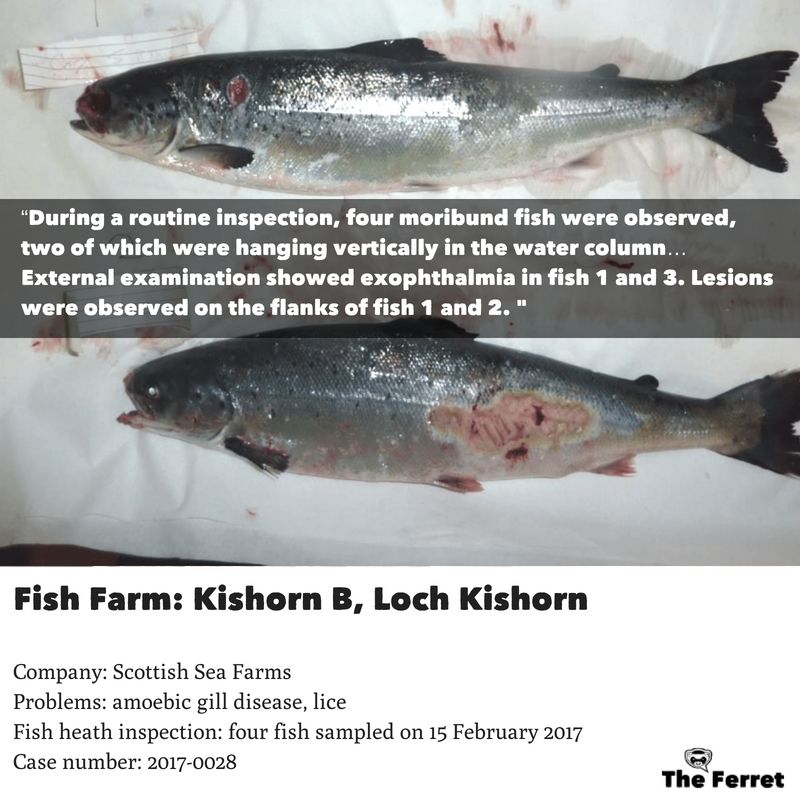
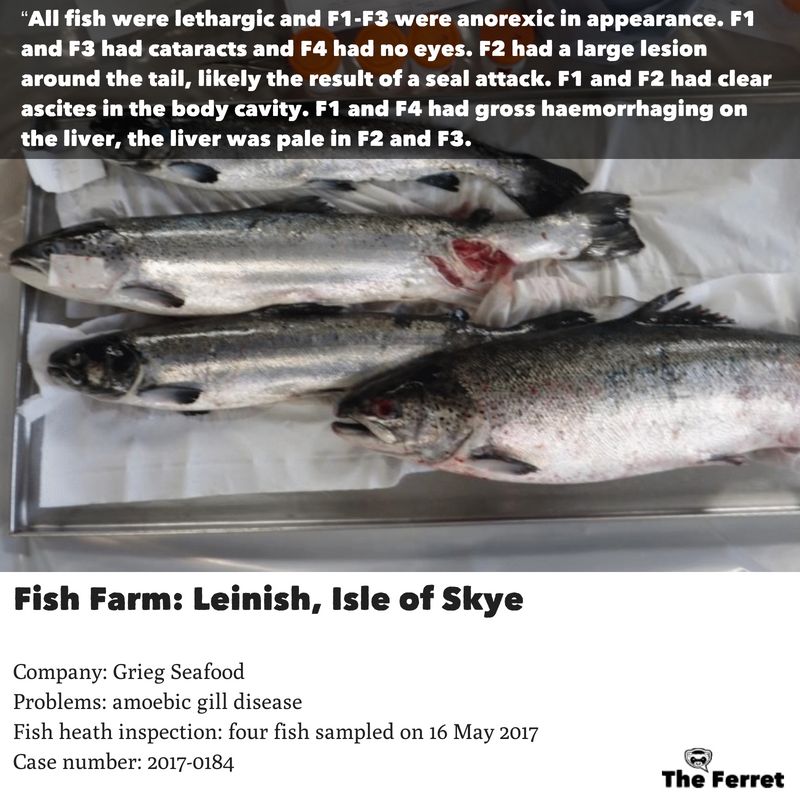

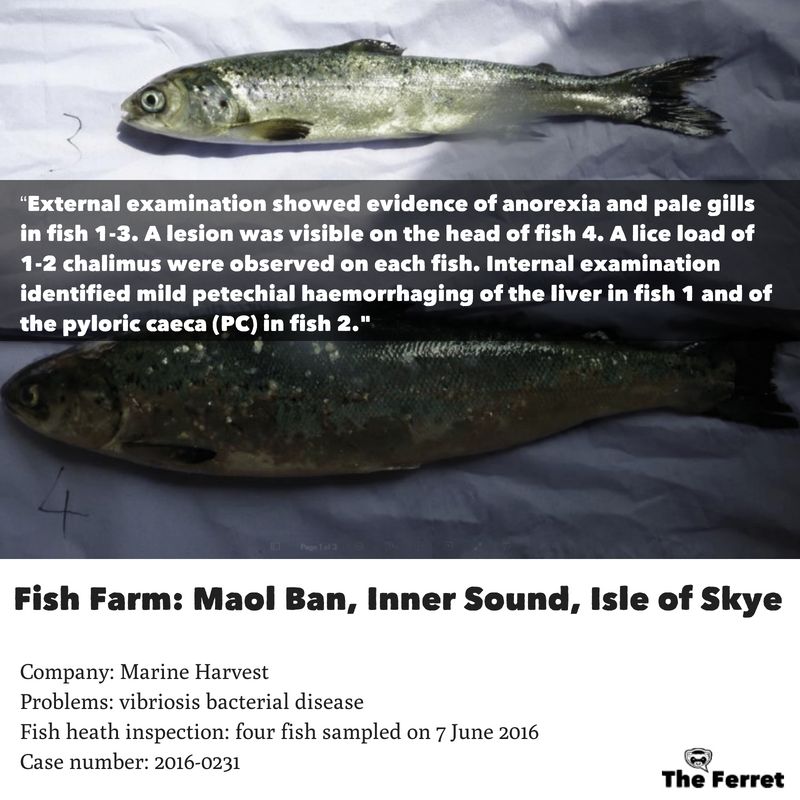

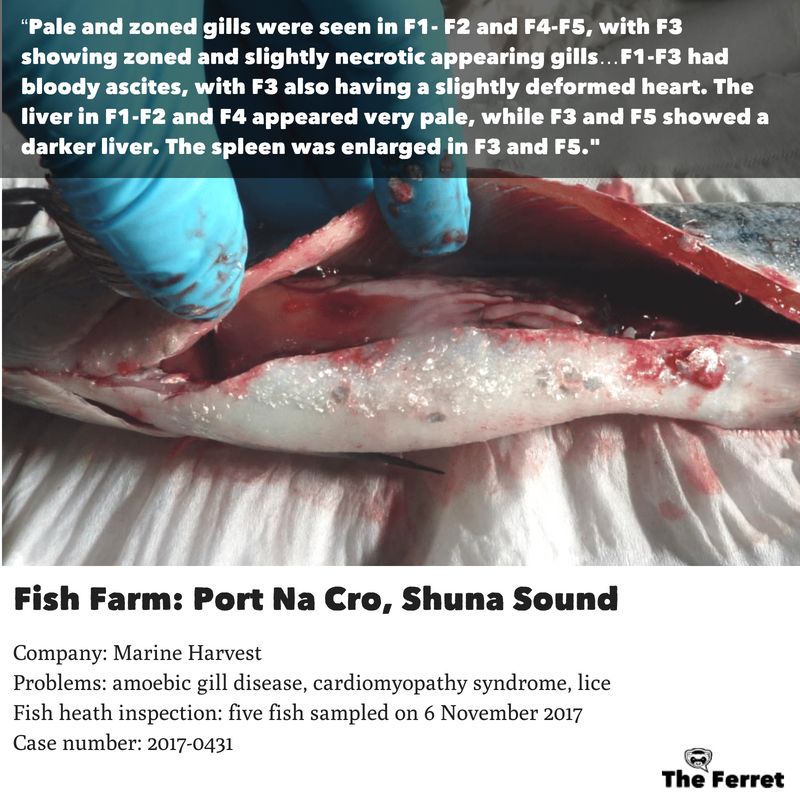
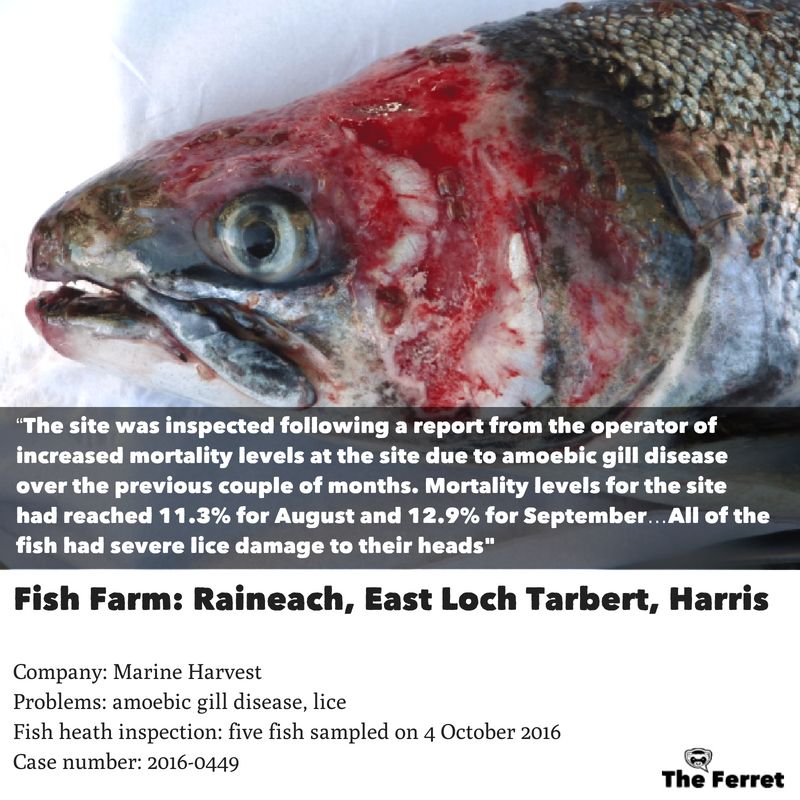
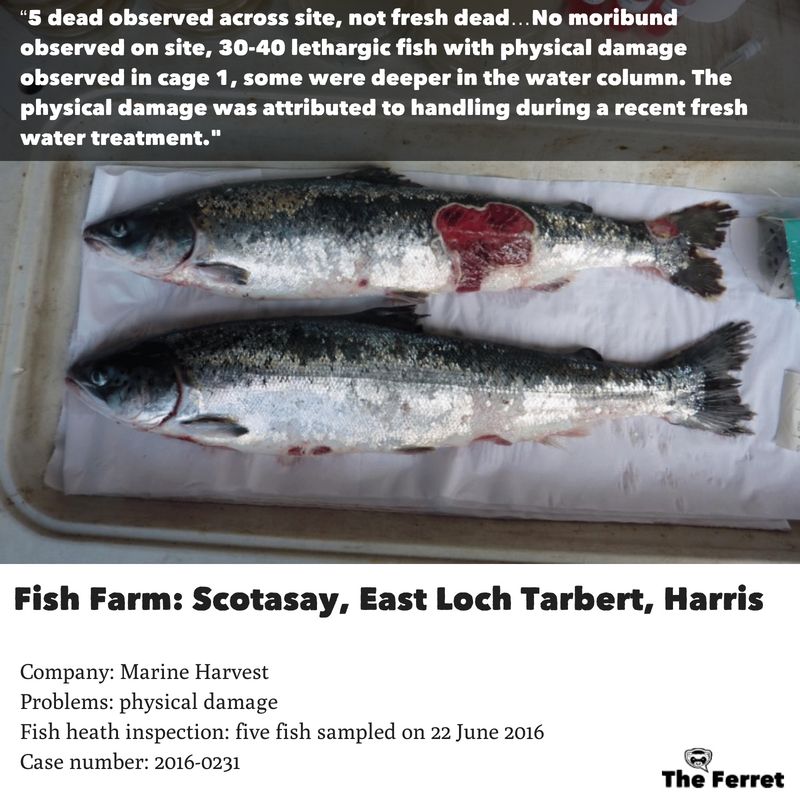
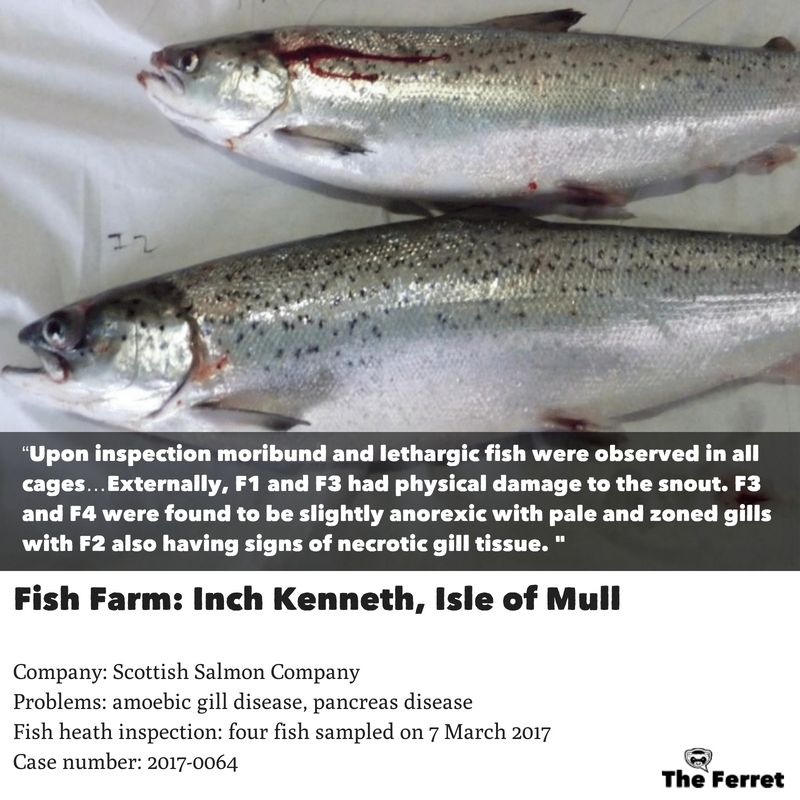
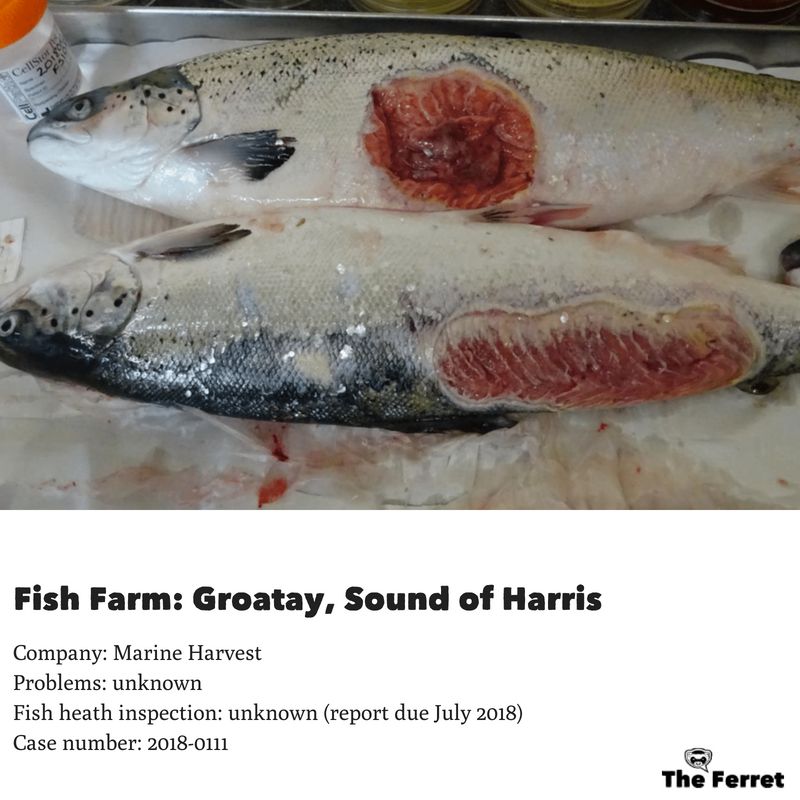

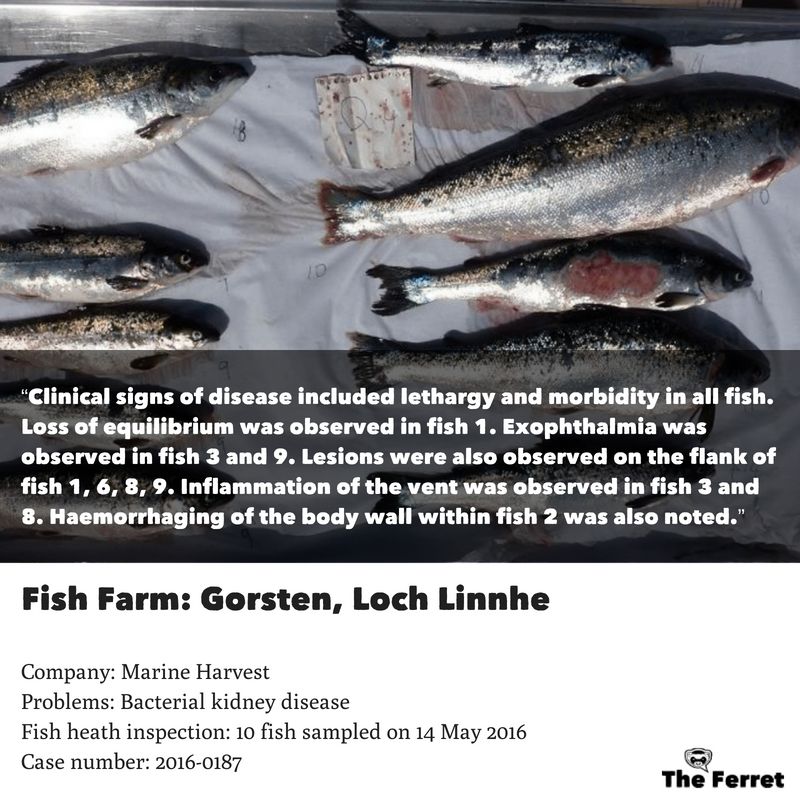
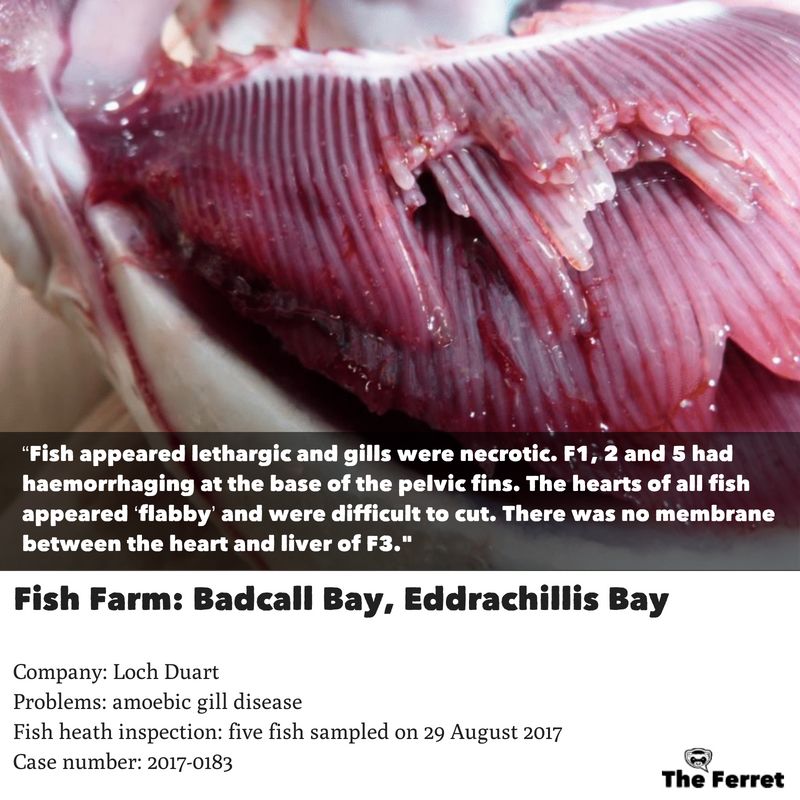
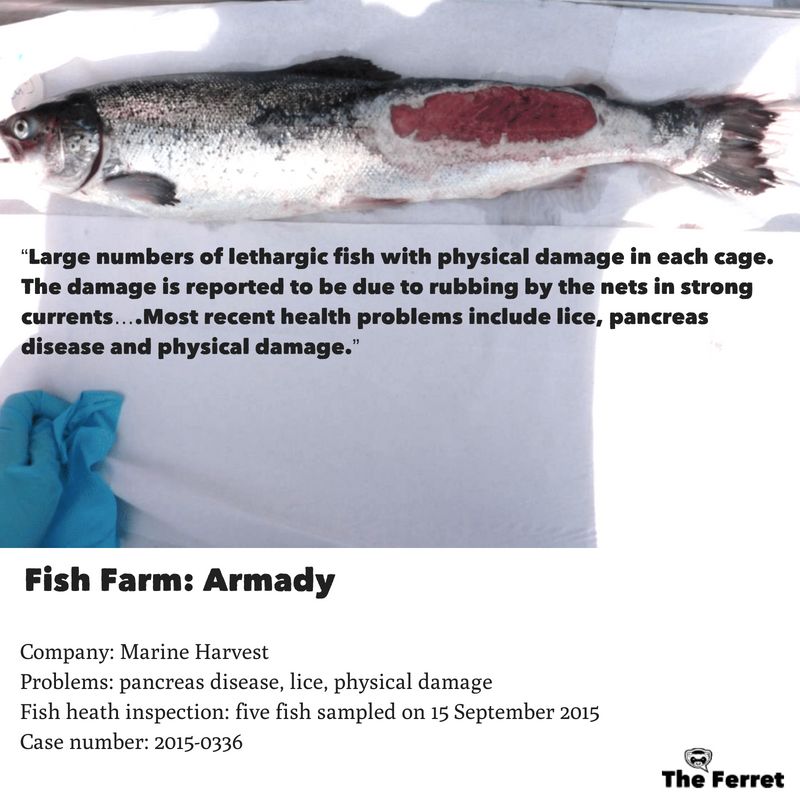


I came here to see what fish I’ve just eaten and how it was farmed. I never realised how complex the industry was. I would say in all honesty, we the consumer are spoilt and maybe we should pay a little more for these beautiful fish. Consumers expecting the best plate of fish for little cost is not realistic and ultimately not sustainable. If consumers want to occupy the moral high ground then they need to justify their presence and put their money where their mouths are..